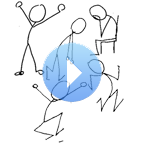
Body Braille™ is one of our signature courses that teaches Pilates instructors how to read their client’s bodies in order to formulate a plan for what exercises will best help them reach their goals. In this video we’re going to take a look at how to use this technique during Side Kicks on the Mat.
We hope you enjoyed this video! Leave your comments below!


Leave A Reply (6 comments So Far)
Please - comments only. All Pilates questions should be asked in the Forum. All support questions should be asked at Support.
You must be logged in to post a comment.
Thanks! That was a very helpful segment. I am training to be a Pilates instructor and am having difficulty with my side lying leg series. I thought I was doing fine until the Master trainer pointed out that my hips were rolling back. Since she pointed this out, I have really been struggling with the side lying leg series. In addition to the exercises you showed here, do you have any suggestions for working towards improving? I struggle most with the front/back kick. Thanks!!
Thanks for this video! I find so often that clients want to really push toward large range of motion too early. Having the fundamentals in place is key to getting the most out of it though.
Well said! Love the smiles!!
Great demonstration!!! I could see the small movement in the hips and the explanation of where the movement should be supported from was very clear. The movement after there were support props was so much more connected. Thanks!
Hi there! Glad you all are enjoying the video, and gleaning some good info from it!
One of the key components to a successful set of side kick series actually doesn’t happen in the exercise at all. Its all about how you prep the body for this long lever leg challenge. Most people (myself included!) walk around the world with very tight, congested hips. And if you bring these people into the side leg series without any foundational work you will either see little to no differentiation between the femur and the pelvis, or a complete lack of mobility. This will result in your clients going to their classic compensatory movement patterns that never garner any real strength.
The solution is an emphasis on release work as a means to free the femur movement from the pelvic movement. When we can increase the baseline glide of the femur head the the hip socket, only then can we strengthen the tissue surrounding this area. This greatly improves gait mechanics and the ability to stabilize the lumbo pelvic area in the side lying position.
For more info on release work, look for our workshop on this important core training principle that is coming to the website soon! Finishing touches are almost done!
Thanks guys! Keep the questions coming!
Casey Marie Herdt
I am a mat instructor who is receiving more clients with skeletal issues, such as rounded shoulders are deviations in the cervical spine, even scolios. This video was must helpful, and I will apply these techniques when class meets again. Will this all work for the greater trochanter, and the sacrum? Thank you soo much for this site!!!!!